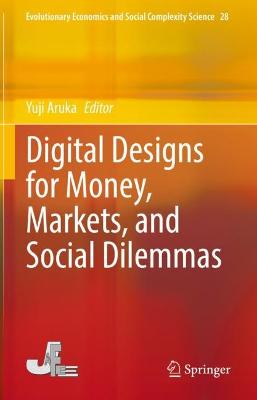Digital Designs for Money, Markets, and Social Dilemmas
 portes grátis
portes grátis
Digital Designs for Money, Markets, and Social Dilemmas
Aruka, Yuji
Springer Verlag, Singapore
05/2022
439
Dura
Inglês
9789811909368
15 a 20 dias
840
Descrição não disponível.
Chapter 1.- A step forward to the future society.- Part 1: Evolution of money and thinking complexities in the AI era.- Chapter 2: 'Good Money Drives Out Bad' among Diversifying e-moneys: Cryptocurrency, Stablecoin, and Digital Community Currency.- Chapter 3: Practical case study About US: Doreming.- Part 2: Good market and the future of labor market.- Chapter 4: Model Structure of Agent-Based Artificial Economic System Responsible for Reproducing Fundamental Economic Behavior of Goods Market.- Chapter 5: AI and the Future of the Labor Market: The Advent of a New Paradigm?.- Part 3: Computational social approaches to social dilemmas, smart city, cryptographics.- Chapter 6: Mathematical framework to quantify social dilemmas.- Chapter 7: Agent-based Simulation for Service and Social Systems and Large-scale Social Simulation Framework.- Chapter 8: Characterization of XRP Crypto-asset Transactions from Networks Scientific Approach.- Part 4: Artificial market experiments.- Chapter 9: The emergence of markets and artificial market experiments.- Chapter 10: Trading Agents for Artificial Futures Markets.- Chapter 11: Default Agent Set for Artificial Futures Market Simulation.- Chapter 12: Programmed trading agents and market microstructure in an artificial futures market?.- Chapter 13: Artificial Intelligence (AI) for financial markets: a good AI for designing better financial markets and a bad AI for manipulating markets.- Part 5: The randomness and high frequencies in the financial data.- Chapter 14: Possible Relationship of the Randomness and the Stock Performance.- Chapter 15: Random Matrix Theory (RMT) application on financial data.- Chapter 16: How does the entropy function explain the distribution of high frequency data?.- Part 6: Other trading strategy issues and the effects of AI usage.- Chapter 17: The Emergence of Periodic Properties of Ordering Strategies under Disruption in the Beer Game.- Chapter 18: Network of investment-oriented social media.- Chapter 19: Student Learning in the Age of AI.
Este título pertence ao(s) assunto(s) indicados(s). Para ver outros títulos clique no assunto desejado.
Evolution of Money;Complexity Thinking;AI Economics;AI Market Experiments;Social Dilemmas;Computational Analysis
Chapter 1.- A step forward to the future society.- Part 1: Evolution of money and thinking complexities in the AI era.- Chapter 2: 'Good Money Drives Out Bad' among Diversifying e-moneys: Cryptocurrency, Stablecoin, and Digital Community Currency.- Chapter 3: Practical case study About US: Doreming.- Part 2: Good market and the future of labor market.- Chapter 4: Model Structure of Agent-Based Artificial Economic System Responsible for Reproducing Fundamental Economic Behavior of Goods Market.- Chapter 5: AI and the Future of the Labor Market: The Advent of a New Paradigm?.- Part 3: Computational social approaches to social dilemmas, smart city, cryptographics.- Chapter 6: Mathematical framework to quantify social dilemmas.- Chapter 7: Agent-based Simulation for Service and Social Systems and Large-scale Social Simulation Framework.- Chapter 8: Characterization of XRP Crypto-asset Transactions from Networks Scientific Approach.- Part 4: Artificial market experiments.- Chapter 9: The emergence of markets and artificial market experiments.- Chapter 10: Trading Agents for Artificial Futures Markets.- Chapter 11: Default Agent Set for Artificial Futures Market Simulation.- Chapter 12: Programmed trading agents and market microstructure in an artificial futures market?.- Chapter 13: Artificial Intelligence (AI) for financial markets: a good AI for designing better financial markets and a bad AI for manipulating markets.- Part 5: The randomness and high frequencies in the financial data.- Chapter 14: Possible Relationship of the Randomness and the Stock Performance.- Chapter 15: Random Matrix Theory (RMT) application on financial data.- Chapter 16: How does the entropy function explain the distribution of high frequency data?.- Part 6: Other trading strategy issues and the effects of AI usage.- Chapter 17: The Emergence of Periodic Properties of Ordering Strategies under Disruption in the Beer Game.- Chapter 18: Network of investment-oriented social media.- Chapter 19: Student Learning in the Age of AI.
Este título pertence ao(s) assunto(s) indicados(s). Para ver outros títulos clique no assunto desejado.







